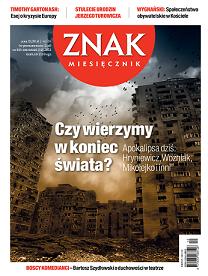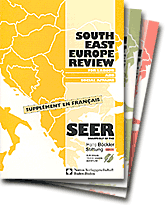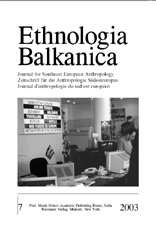
We kindly inform you that, as long as the subject affiliation of our 300.000+ articles is in progress, you might get unsufficient or no results on your third level or second level search. In this case, please broaden your search criteria.


Author conducts functional analysis of research and managerial aspects of competitiveness at the meso-level. From the methodological point of view, dialectical and synergistic approach to study of the region's competitiveness is assessed in the context of globalization and regionalization in the systemic, dynamic and nonlinear aspects. With regard to this study, along with synergistic and dialectical methodological tools it has been suggested to use a systemic cognitive model, which is based on a systemic paradigm. According to the paradigm, socio-economic area of competitiveness is seen as a single system, enclosing a set of independent subsystems, the composition and structure of which is determined in accordance with the specific features of the determinants of competitiveness in the region.
More...
This article applies to the proposed introduction of a special bank tax, which is currently under discussion in both Europe and the USA. The paper observes the possible models of such a bank tax. It describes several types of bank tax, which has already been introduced in some countries; discusses whether this is actually an anti-crisis instrument, and characterized the key works that take place over such a tax in the European Union.
More...
The paper is devoted to energy demand forecasting in Uzbekistan. Studies show that in spite of the abundant reserves of hydrocarbons, low energy efficiency can have an adverse impact on energy security in Uzbekistan in the future. Oil and gas are the main primary energy source and they ensure energy security of Uzbekistan. Energy demand forecasting is essential in order to develop an effective energy policy. Such forecast can be useful to plan oil and gas production volumes, to identify priorities for the industrial modernization and to create favorable conditions for sustainable economic development in the future. Author proposes model based on translog function for developing medium-and long-term development programs in energy sector and the modernization and technological re-equipment of industry.
More...
The goal of this paper is to compare the development of the Lithuanian and Russian biotechnology sectors. In case of Lithuania we tried to uncover what are the circumstances surrounding the favorable development of the biotechnology sectors in Lithuania. In case of Russian Federation we looked at encouraging as well as discouraging circumstances surrounding this segment of economy. Drawing upon Schumpeter’s ideas of innovation and Porter’s business cluster theory, we argue that Lithuania is “at the right place and the right time” to make it a regional leader in Baltic biotechnology. Russia, on the other hand, is in the process of developing biotech sector in order to at least to catch up with other countries (including Lithuania). It will take time and continuous governmental support for Russia before this sector starts contributing significantly to Russian economy.
More...



The Lucas critique has exposed the problem of the trade-off between changes in monetary policy and structural breaks in economic time series. The search for and characterization of such breaks has been a major econometric task ever since. We have developed an integral technique similar to CUSUM using an empirical model quantitatively linking the rate of inflation and unemployment to the change in the level of labour force in Canada. Inherently, our model belongs to the class of Phillips curve models, and the link between the involved variables is a linear one with all coefficients of individual and generalized models obtained by empirical calibration. To achieve the best LSQ fit between measured and predicted time series cumulative curves are used as a simplified version of the 1-D boundary elements (integral) method. The distance between the cumulative curves (in L2 metrics) is very sensitive to structural breaks since it accumulates true differences and suppresses uncorrelated noise and systematic errors. Our previous model of inflation and unemployment in Canada is enhanced by the introduction of structural breaks and is validated by new data in the past and future. The most exiting finding is that the introduction of inflation targeting as a new monetary policy in 1991 resulted in a structural break manifested in a lowered rate of price inflation accompanied by a substantial fall in the rate of unemployment. Therefore, the new monetary policy in Canada is a win-win one.
More...
In this paper we examine the concept of an Environmental Kuznets Curve (EKC) hypothesis in a critical way aiming to justify its existence as well as to propose policies compatible with sustainable development. For this reason, we make use of a data set on CO2 emissions for 32 countries over a 36 year time period. For this balanced panel database, we apply a number of econometric methods to estimate the income-environment relationship. Our results indicate the existence of N-shaped relationship between economic development and pollution. However we show that the turning points calculated by panel data analysis may not reveal the actual turning points valid for individual countries. In our case and using different countries from different geographical regions we found a mixture of monotonic or inverted U-shape or N-shape behaviour. Countries are heterogeneous with different stochastic regression coefficients. This implies that the use of the total N-shape income-environment relationship by policy makers may be misleading with serious policy ineffectiveness implications.
More...
In this study, we test whether the behavioural bias labelled “disposition effect”, defined as the tendency of investors to ride losses and realize gains, leading to asymmetric return-volatility relation before and during subprime crisis periods. The study of the cross-sectional relation between past cumulative return, current return and volatility shows that volatility is less sensible to return chocks when cumulative past return is positive. Using the capital gain measure of Grinblatt, and Han (2005), we examine the relation between capital gain, current return and volatility for American stocks during tranquil and turmoil periods. We find that negative capital gain of disposition investors explain a large part of asymmetric volatility mainly in subprime crisis period. Moreover, volatility is less sensitive to return shocks under positive capital gain before subprime crisis. Although, during subprime crisis period positive capital gain increases volatility of bigger stocks. This finding can be explained by the loss aversion bias which leads investors to take their positions because of increasing of failure risk during global financial crisis period.
More...
Various effects of the financial deepening came to the centre of academics as well as policy-makers discussions during last four decades especially in relation to the financial sector development. Together with financial liberalization and international financial integration economists focus their attention to the financial deepening especially due to its potential effects on the real economy. Perspective of the fast and sustainable economic growth at the end of the 1990s increased an attractiveness of the European transition economies (ETE) for the foreign investors that resulted in increased foreign capital inflows to ETE. International capital inflows (especially debt and portfolio capital flows) stimulate financial deepening through higher demand for financial services. As the underdeveloped financial markets obviously constrain domestic capital mobilization, the international financial integration is considered to be very useful vehicle in fostering financial sector advancement. One of the most discussed areas related to the overall effects of the financial deepening is a bi-directional relationship between financial development and economic growth. It is generally expected there is a positive effect of financial development on economic growth. On the other hand especially some country-specific institutional characteristics and different policies may significantly distort positive incentives of the financial deepening. In the paper we analyze the main aspects of the financial deepening in ten ETE in the period 2000-2010 using vector error correction model (VECM). In order to meet this objective we implement a multivariate cointegration methodology introduced by Johansen (1988, 1991) and Johansen and Juselius (1990) to estimate the relationships between financial depth indicators and real output in the selected group of countries. To find the order of integration of endogenous variables we test the time series for the unit root presence. In order to determine cointegrating (long-run) relationships, we follow a Johansen cointegration procedure to perform the trace test and maximum eigenvalue test. We also test the direction of the causality relationships between financial depth indicators and real output using linear Granger causality test. Using the estimated VEC model, the dynamic responses of the endogenous variables to the money stock, domestic bank deposits and domestic bank loans one standard deviation shocks are computed for each country from the group of ETE.
More...
The object of this particular research paper is the analysis of all five investment funds in Romania, having five or more years of continuous activity on the Romanian capital market, through 60 monthly probes. Within a context of a macroeconomic environment characterized by uncertainty, a correct assessment of an investment prior to its inception becomes impetuously necessary. The starting point of this research was facilitated by similar studies in the field such as Sinclair (1990) Phoon, Tan (1993), Gallo, and Swanson (1996). The methodology of research includes testing of managerial abilities based on the established models of Jensen (1968), and Henriksson , and Merton (1984). The added value of this paper consists in the inclusion of two other aspects: namely the yield and the global risk associated to the portfolio using the CAPM model and the stationarity analysis of the series based on the Ljung-Box and the Box-Pierce tests. One of the conclusions of this research was that none the fund managers have either “selection ability” or “timing ability”. However, risk and return analysis determined that the same group of managers achieved a harmonious grouping of the companies in their respective portfolios. As a result of the analysis performed, all data series were proven to be non-stationary, the funds themselves presenting a type DSP non-stationarity compared to the TSP type non-stationarity of the BET index series. Therefore, we used differentiation for the fund share price value and we have eliminated the trend of the BET index series using the Moving Average.
More...
This contains the Table of contents of Valahian Journal of Historical Studies
More...
Vecgulbene (Alt-Schwanenburg) manor is situated in Gulbene District within the territory of the town of Gulbene, which has been a crossroads since ancient times. The manor is known as one of the most prominent and splendid ensembles in Latvia and possibly in the Baltic region. This place suffered considerably during the wars and the Soviet period and therefore the research and promotion of these cultural and historical values would seem to be an urgent task. Construction and reconstruction of the so-called White Palace at 12 Brīvības Street has been dated differently by various sources. First it was stated that the central part had already been built in 1763 and reconstructed in 1840s –1870s. Art historian Dainis Bruģis holds that the Palace was built around 1840, which seems to be a more plausible version; construction was carried out by the Wolff family, possibly by Rudolf Gottlieb Magnus von Wolff (1809–1847) and entries in his daughter Isabella’s diary attest to this. Rudolf von Wolff had travelled to many countries including Italy. The style of Italian villas evident in the White Palace surely comes from Rudolf’s taste and interests. The Palace was inherited by Rudolf’s son Johann Heinrich Gottlieb von Wolff (1843–1897) who reconstructed and enlarged the building in the last quarter of the 19th century. The architecture of the Palace was influenced by the Renaissance. The project resembles the Renaissance villas found among Andrea Palladio’s works. The central two-storey block was almost cube-shaped and flanked by single storey wings at both ends. The façades were lavishly decorated. The central volume featured wide, fluted Colossal order pilasters; triangle-shaped, plastic frontons were placed over the ground floor window openings. The park side had a wide terrace that connected the building with the surrounding environment; the terrace is similar to Villa Pamphili by the 17th century architect Alessandro Algardi. The original exterior is captured in a photo published by Heinz Pirang in the 1860s and also preserved in a drawing by Wilhelm Siegfried Stavenhagen from 1862. The next landlord Heinrich von Wolff disliked the Palace and ordered wide-scale reconstruction works. Retaining the core of Italian villa and Renaissance forms, the building acquired two towers – one by the main entrance and the other at the end of the opposite single storey block that became the main vertical accent. The building was changed from symmetric to asymmetric, adding an expressive silhouette and picturesque shapes typical of Romanticism-inspired Neo-Gothic palaces. The decorative finish of the façades was very elaborate, especially that of the two towers, featuring ornamental and sculptural decorations. These are reminiscent of decors found on Riga’s Eclecticism-style buildings. The author of the reconstruction remains unknown, but these decorations had been mass produced and available to any well-off person at the time.
More...
As soon as Art Nouveau began to appear in the architectural décor of Riga at the turn of the 19th and 20th centuries, depictions of nature became increasingly popular. Of course, there was not just the main and specific Art Nouveau approach, which Robert Schmutzler cleverly described as “Biological Romanticism”, there were also other ways of approaching the natural world. Paul Greenhalg has described this as “symbolic conventionalisation”, pantheism, metamorphosis and evolutionism. Pantheism became the main strategy for interior design at the turn of the 19th and 20th centuries in Riga, particularly insofar as vestibules are concerned. By contrast, façades manifested ideas of conventional Symbolism or of metamorphosis and evolutionism. Stylisation of natural motifs was one of the most popular techniques in designing wallpaper and stencilled décor on walls. Specialist publications had a major influence when it came to selecting the range of colours and ornamentation and since the mid 19th century their number had increased very rapidly. In Riga, as in several other provincial centres in the Russian Empire, Historicism played a particularly important role in architectural décor. When architects and designers began to move toward Art Nouveau it was often in the context of a reinterpretation of motifs that were popular in various neo-styles. New meaning was also attached to motifs and subjects that had been tested in the decorative arts and remained well known in the latter half of the 19th century and whose sources were to be found in various popular publications such as the ornamental handbook by Franz Sales Meyer, the edition “Alegorien un Embleme” issued by Martin Gerlach, etc. The interest in emblems and heraldry in particular that had been inherited from the 19th century endured throughout the period under review. Façade décor features both natural depictions of flora and fauna and their stylisations. Along popular Art Nouveau motifs (water-lilies, poppies, lilies, peacock, snake, and stylised motifs of the sun), traditional motifs from historic styles were also widely used. In the latter period of Art Nouveau, the depiction of motifs from nature no longer stressed the aesthetics of its primal forces but opted more for the depiction of man’s conquest of nature. Motifs were strongly stylised, and subject matter included hunting scenes as well as the depiction of flowers in vases or baskets. One important aspect of the conceptual decorative forms of Art Nouveau relates to the unusual cult of line that was characteristic of the style. Independent asymmetrical use of linear motifs in the plastic décor of façades in Riga was uncommon. Asymmetrically curved lines or rhythmic lines were more often used in the depiction of natural motifs, as well as anthropomorphic motifs, especially masks and hybrid creatures. One aspect of the linearism typical of Art Nouveau could be seen in the tassel of bows motif.
More...
The article reports the seminar "Kopierte Vergangenheit. Rehistorisierungen von Stadtzentren in Polen und Baltikum" ("The Copied Past. Rehistorisation of City Centres in Poland and the Baltic States") held in Sankelmark from 13 to 15 March 2009. The event was organised by the Northern Education Centre with participants from Germany, Poland, Lithuania, Kaliningrad and Latvia.
More...
The aim of this research is to determine the scientific and legal level of educational administration and supervision activities in Turkish ministries. Document analysis which is a qualitative research technique has been used for the study. The study has been conducted on data, collected from internet, based on inservice training regulations and internal supervision instructions of ministries. Descriptive analysis is used in data analysis process. In-service training regulations, that are examined, are evaluated under seven categories in terms of administration processes. These categories are; decision making, planning, organizing, communicating, influencing, coordinating and evaluating. Internal supervision unit guidelines are evaluated under six categories which are; defining what to be supervised, preparations before supervision, defining the standards, data collection before supervision, cross-control of supervision data and standards, and reporting. The findings reveal that the most frequent in the administrative process is evaluating, and the least one is coordinating. The administrative processes are most cited by The Ministry of Health, but least by administrative The Ministry of Forest and Water Affairs. The ministries have cited the same supervision processes equally.
More...